
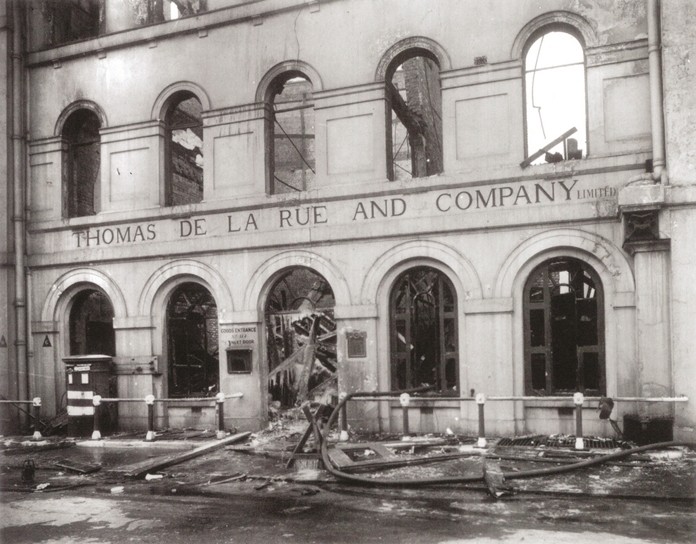
In 1946 the Thai Government tried to place an order with Thomas de la Rue & Company Limited London (TdlR), but unfortunately they were unable to receive the order as their works on Bunhill Row had been bombed during WWII.
Please Support Pattaya Mail

 Thailand had great demand for banknotes and turned to the U.S. Government for assistance. The U.S. Bureau of Engraving prepared the printing plates and the Tudor Press Inc. did the printing. They printed 1-, 5-, 10-, 20- and 100 Baht Banknotes. Initially the paper used for these banknotes were watermarked “MILITARY AUTHORITY” and later plain paper was used. More than 300 million of these notes were printed.
Thailand had great demand for banknotes and turned to the U.S. Government for assistance. The U.S. Bureau of Engraving prepared the printing plates and the Tudor Press Inc. did the printing. They printed 1-, 5-, 10-, 20- and 100 Baht Banknotes. Initially the paper used for these banknotes were watermarked “MILITARY AUTHORITY” and later plain paper was used. More than 300 million of these notes were printed.


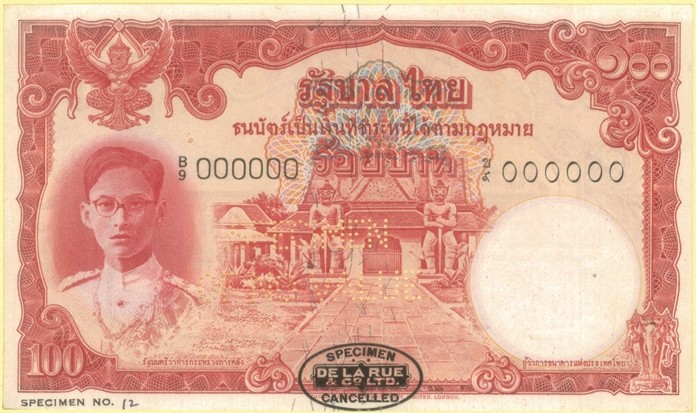 TdlR was able to produce banknotes for Thailand later and the first notes were announced in 1948. The notes had the same designs as Fourth Series, 1-, 5-, 10- and 20 Baht banknotes produced by TdlR. The 100 Baht Fourth Series was not produced for circulation. TdlR had produced a Specimen note of the 100 Baht for the Fourth Series in blue, and this design was used for the 100 Baht Ninth Series, which was red. The portrait of King Bhumibol Aduljadej, Rama IX, was to the left on all Ninth Series denominations.
TdlR was able to produce banknotes for Thailand later and the first notes were announced in 1948. The notes had the same designs as Fourth Series, 1-, 5-, 10- and 20 Baht banknotes produced by TdlR. The 100 Baht Fourth Series was not produced for circulation. TdlR had produced a Specimen note of the 100 Baht for the Fourth Series in blue, and this design was used for the 100 Baht Ninth Series, which was red. The portrait of King Bhumibol Aduljadej, Rama IX, was to the left on all Ninth Series denominations.

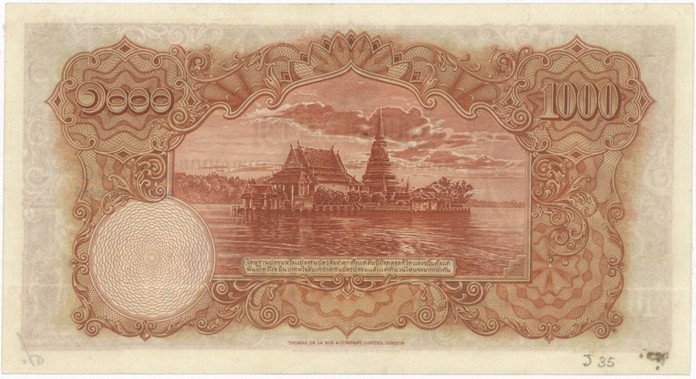 King Prajadhipok, Rama VII, was the first Thai King who granted Royal permission to have his portrait on a banknote. A 1000 Baht banknote was produced, but was never put in circulation because His Majesty abdicated before it could be printed.
King Prajadhipok, Rama VII, was the first Thai King who granted Royal permission to have his portrait on a banknote. A 1000 Baht banknote was produced, but was never put in circulation because His Majesty abdicated before it could be printed.

 During the reign of King Ananda Mahidol, Rama VIII, a 1000 Baht banknote was produced with the same obverse design as the never issued 1000 Baht which bore the portrait of Rama VII. The picture on the reverse was changed from Phra Samut Chedi Temple on the Third Series to that of the Anantasamakorn Throne Hall on the Fourth Series.
During the reign of King Ananda Mahidol, Rama VIII, a 1000 Baht banknote was produced with the same obverse design as the never issued 1000 Baht which bore the portrait of Rama VII. The picture on the reverse was changed from Phra Samut Chedi Temple on the Third Series to that of the Anantasamakorn Throne Hall on the Fourth Series.
 In 1948 Thailand considered producing a 1000 Baht banknote for the Ninth Series. The size of the 1000 Baht Fourth Series was 10.5 cms x 19.5 cms and the colour was reddish pink. For the Ninth Series this size and colour was considered. H.H. Prince Viadhanajaya, Governor of the Bank of Thailand from 3 September until 2 December 1948, ordered the new 1000 Baht to be longer than the 100 Baht note, the note should be 8.7 cms x 15.7 cms. Several colours were considered. Finally, brown with a touch of green colour was decided upon. The original artwork for the reverse was produced in this colour, but the notes produced for circulation were printed in violet.
In 1948 Thailand considered producing a 1000 Baht banknote for the Ninth Series. The size of the 1000 Baht Fourth Series was 10.5 cms x 19.5 cms and the colour was reddish pink. For the Ninth Series this size and colour was considered. H.H. Prince Viadhanajaya, Governor of the Bank of Thailand from 3 September until 2 December 1948, ordered the new 1000 Baht to be longer than the 100 Baht note, the note should be 8.7 cms x 15.7 cms. Several colours were considered. Finally, brown with a touch of green colour was decided upon. The original artwork for the reverse was produced in this colour, but the notes produced for circulation were printed in violet.

TdlR used the prefix A/5 on the 1000 Baht specimen notes. The first time this prefix was used was on the 5 Ticals/Baht First Series.
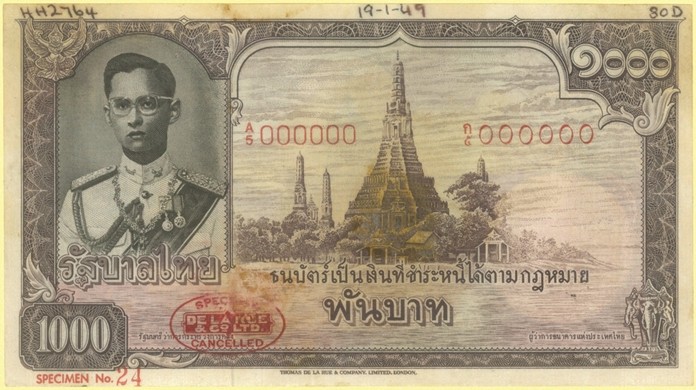


TdlR had in their archives a 1000 Baht note with a red/oval “DE LA RUE & CO LTD.” stamp on the lower left corner. “SPECIMEN No. 24” in red stamped on the lower left margin. In the upper left margin is a pen annunciation “HH2764”, in the middle upper margin the date “19-1-49” and in the upper right margin the TdlR archive reference “80D”.
A 20 Baht specimen banknote has a pen annunciation for the date “22.4.47” on the upper right margin and the archive reference “79K”. 10 Baht notes had an archive reference “78”, 5 Baht “77” and the 1 Baht “76”. Later for the Ninth Series, TdlR changed the system of their archive references.
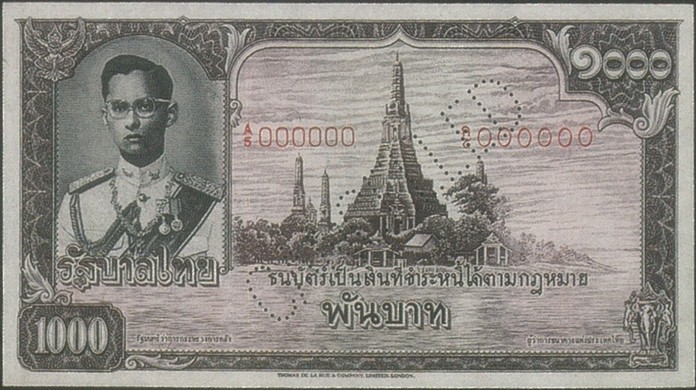
This is a rare specimen note from the archives of TdlR. It is perforated “CANCELLED” across with no red/oval “DE LA RUE & CO LTD.” stamp lower left. Unfortunately this banknote was stolen after it was sold at a Spink auction sale in London on 25 April 2002. A reward is promised for the safe return of this rare specimen banknote.

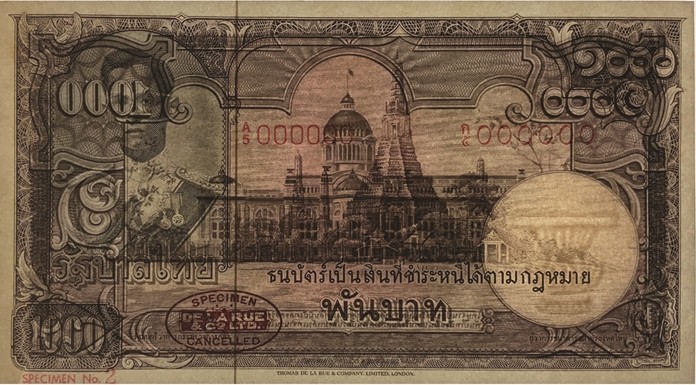
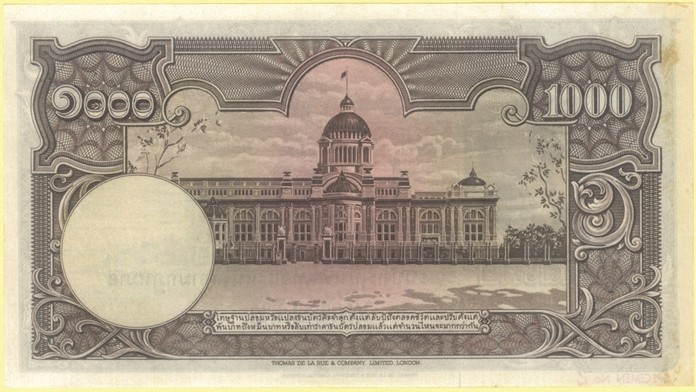
Other banknotes known from the archives of TdlR with the red/oval “DE LA RUE & CO LTD.” stamp on the lower left is “SPECIMEN No. 2, 4, 12, 21, 26, 29 and 39” stamped in red in the lower left margin.


“SPECIMEN No. 29” was sold at a Spink auction on 23 June 2001 as lot 173, for SG$ 21,275. In the sale there were several banknotes from the TdlR archive. The note had the red/oval “DE LA RUE & CO LTD.” stamp on the lower left. It also has a small “SPECIMEN” perforated diagonally across the centre. This is the only 1000 Baht note of this type seen with this perforation.



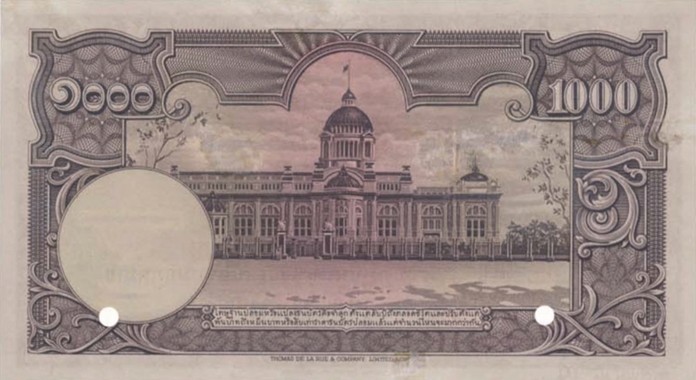
A collector bought “SPECIMEN No. 39” in Eur-Seree Auction #31 on 24 March 2013 for 300,000 Baht. The banknote had traces of mounting glue in several places and two security punched holes. The note went through a conservation process and was later put up in Eur-Seree auction sale #45 on 28 May 2017 together with 1-, 5-, 10-, 20- and 100 Baht with a starting price of Baht 1,200,000. This set did not find a buyer at this auction.

From 2014 until today the specimen notes from the archives of TdlR have been sold between 300,000 Baht to 1,000,000 Baht. The best buy is probably “SPECIMEN No. 21” sold in Eur-Seree auction #36 on 30 November 2014. It was graded by PMG to be 64, Choice Uncirculated with pencil annotation “80B”, the TdlR archive reference, with traces of mounting on the reverse right margin. Many specimen notes from the TdlR archives have traces of mounting. The hammer price in the auction was 360,000 Baht.


In 1949 the Bank of Thailand received approval from the Treasury Department to commission TdlR to print the 1000 Baht banknote Ninth Series. A discussion as to how many should be printed led to the Governor of the Bank of Thailand, M.L. Dej Sanidvongs writing a letter on 26 June 1950 to the Permanent Secretary of the Ministry of Finance with a recommendation to print 1,000,000 notes. On 18 March 1952 it was decided to print 500,000 notes. The notes arrived in Thailand in September 1952. After the notes arrived, caution of inflation was raised. Therefore the notes were not put in circulation but incinerated. Approximately 100 banknotes were left as samples. One of these banknotes can be seen in the Bank of Thailand Museum. This note has “SPECIMEN” stamped in red in two places on the obverse, which were also done on several of the other specimen Ninth Series notes in Bangkok.


When the notes were shipped from England the printed signatures and numbers were not added. This was done in Thailand for security reasons. The specimen notes kept by TdlR had the prefix A/5 and the number 000000.
One note is known to have the correct printed signatures, that of Minister of Finance General Bhau Bienlert Boribhand Vuddakich and Governor of the Bank of Thailand Serm Vinieehayakul. It has prefix A/1 and the number 000930. This note was actually prepared for circulation even if it was never officially announced. The note was bought in the 1990’s by the late well-known collector Wichai Sangunasin who acquired the note from a dealer at the JJ market. Circa 2003 well-known dealer and author of coin and banknote catalogues Surachai Smitasin bought it. Surachai and his family sold it at Eur-Seree auction #44 on the 1 & 2 April 2017. The banknote was sold for Baht 1,500,000 in the auction. The auctioneer determined this UNIQUE banknote to be in Very Fine condition with some folds and some stains. Having been kept in warm and humid conditions for 65 years, this banknote had gone through a restoration process.
Must Read: 1000 BAHT 1949-1952 (Part 2)
Read about the exciting events when in 2015 other types and colours of the 1000 Baht banknote turned up in the market!
|
Bibliography and Sources: |
 |
 |
 |





